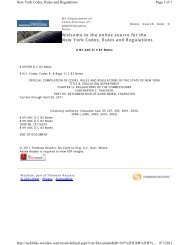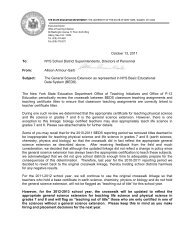ESL Learning Standards - Higher Ed - New York State Education ...
ESL Learning Standards - Higher Ed - New York State Education ...
ESL Learning Standards - Higher Ed - New York State Education ...
Create successful ePaper yourself
Turn your PDF publications into a flip-book with our unique Google optimized e-Paper software.
Standard 2: Continued<br />
Elementary Grade Sample Classroom Tasks:<br />
English Proficiency Level<br />
Beginning<br />
Teacher reads a simple fable or legend (e.g., Aesop,<br />
Leonni, Steig, Noble). Teacher develops a story map and<br />
identifies the problem and the solution. Class discusses<br />
what lesson/moral is taught. Process is repeated with additional<br />
fables/legends. When students are familiar with the<br />
genre, teacher may stop during a reading and ask students<br />
to predict a solution. Students draw pictures of a fable or<br />
legend they think teaches an important lesson, and write<br />
brief captions.<br />
Performance indicators: 1, 2, 3, 5<br />
Intermediate<br />
Students complete Beginning task. When students are<br />
familiar with the genre, pairs of students guess the lesson/moral<br />
taught by the fable or legend and share their<br />
opinions with the class. In their reading logs, students create<br />
a chart to list and describe genres read. Students write<br />
a paragraph explaining the genre and reflecting on the<br />
value of fables and legends.<br />
Performance indicators: 1, 2, 3, 4, 5, 7, 9<br />
Class reads or listens to a few stories with dialogue (e.g.,<br />
Frog and Toad, Three Billy Goats Gruff). Teacher converts<br />
stories to simple scripts. Students work in small groups to<br />
learn parts and present the skits. Teacher provides a simple<br />
checklist to guide and evaluate the skits.<br />
Performance indicators: 1, 6, 9, 11<br />
Class reads a few stories with dialogue (e.g., Frog and<br />
Toad, Three Billy Goats Gruff). Students work in small<br />
groups to convert stories to scripts. Class develops a simple<br />
checklist to guide and evaluate the performances. Students<br />
memorize parts, and they rehearse and present skits, using<br />
simple props.<br />
Performance indicators: 1, 6, 9, 11<br />
<strong>ESL</strong><br />
2<br />
Elem<br />
Students are introduced to poetry elements through nursery<br />
rhymes with visuals (e.g., using Steck Vaughn’s Magnetic<br />
Way). After listening to the rhymes and manipulating the<br />
visuals, students begin saying the rhymes aloud chorally,<br />
first in unison, then by alternating lines (alternate between<br />
girls and boys or between any other two groups in the<br />
class). Students watch teacher write out the poem and listen<br />
for the rhyming words. Students circle, highlight, or<br />
underline the rhyming words on their own copy of the<br />
piece. Students take turns reciting the poem aloud and acting<br />
it out.<br />
Performance indicators: 1, 2, 3, 6<br />
Teacher and students read and reread aloud various poems<br />
together. Students look for poetry and bring it to class to<br />
share. Teacher explains poetic devices and form (see<br />
Advanced task) as they arise in works shared. Each student<br />
keeps a poetry journal to write in daily (new poem, revision,<br />
or brainstormed list of ideas). Teacher can provide<br />
poetry starter ideas (see Transitional task). Poems are<br />
works in progress; teacher provides general feedback to<br />
guide students in editing. Poetry party is planned to provide<br />
a forum for making poems “public.” (See Sunrises<br />
and Songs: Reading and Writing Poetry in an Elementary<br />
Classroom by Amy A. McClure.)<br />
Performance indicators: 1, 2, 3, 5, 6, 8<br />
50 <strong>Learning</strong> <strong>Standards</strong> for <strong>ESL</strong>
















